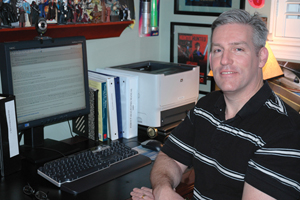Government Work—At Home
Attorney John Dalier has been with the U.S. Patent and Trademark Office for 15 years, with much of that time spent working at home. Most days he’s at his downstairs desk by 5:30 a.m., breaks around 7:30 to help send his children off to school and returns to work by 9:00. Finishing around 3:30 p.m., Dalier, a trademark examiner, typically completes more than eight productive hours without getting behind the wheel of a car, fighting District of Columbia traffic or shelling out bucks for gas and parking.

John Dalier
Photo courtesy of USPTO
He spends a required two days out of every two-week period at the agency’s Alexandria, Va., offices, attending meetings and getting face time with colleagues.
“The amount of work I do now is more than when I worked onsite,” says Dalier, a resident of McLean, Va., who began working remotely for the agency in 2001. “With a work-at-home program you have a lot more flexibility and control of your day.”
Dalier is part of the PTO’s growing population of teleworkers. Once operating outside standard protocol, they now compose more than half of the agency’s nearly 9,600 staffers. Their ranks, including many lawyers, are helping to set the standard for successful work-at-home initiatives throughout the federal government.
The PTO began testing telecommuting in 1997 when it launched a pilot program with 18 attorneys. Today it has a well-honed program offering off-site work options to more than 6,500 eligible employees.
Dalier and others who work four out of five days offsite are known as “hotelers.” The designation stems from the use of an electronic concierge system to reserve office space on the days they report in. Through the first quarter of 2010, there were 2,347 hotelers, as well as 2,669 staff members working from home at least one day a week.
STRICT STANDARDS
The senior agency adviser in charge of the program, Danette Campbell, says the effort is successful because the PTO adheres to rigorous standards for training and job performance. The agency also provides workers with technology—computers, faxes, and access to agency systems and online research—to replicate the office environment in their homes.
“Because of the strategic design, the USPTO has become the go-to agency for other federal agencies that are interested in starting or expanding telework initiatives,” Campbell says. “Telework here is really a business strategy.”
There’s nothing like bad weather to demonstrate the system’s effectiveness. During the severe snowstorm that crippled Washington in early February, the Patent and Trademark Office teleworkers remained largely unconcerned, Campbell says. Some 3,000 staffers logged in during the blizzard’s three worst days, she notes.
There are considerable cost savings, to boot. Campbell says the program may have saved an estimated $11 million in real estate costs, not to mention its impact on the carbon footprint. And hotelers alone reduce automotive emissions by some 10,638 tons a year, she says.
Though the program is not for everyone, it is particularly well-suited to the standardized legal work of the PTO, where attorneys’ results can be clearly evaluated.
“We are basically a production shop,” Campbell says. “These folks know at the end of every bi-week exactly what they have to produce. It doesn’t matter if they’re here on the Alexandria campus or in West Virginia.”



